by Heather Plett | Nov 12, 2013 | Beauty
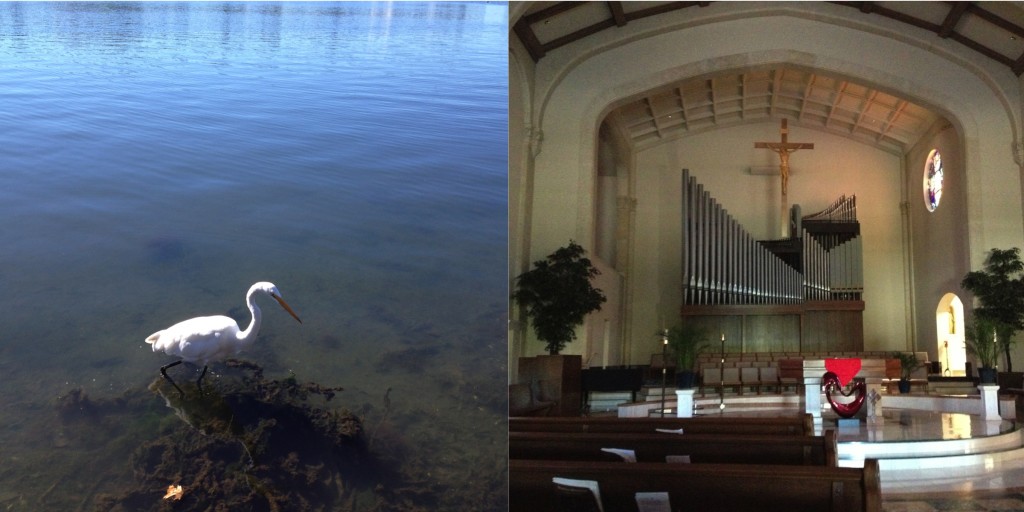
I sat on the shores of the lake, watching the birds float and fly past. A cormorant stood on a post, its wings spread wide to the sunshine. The lake is a wildlife sanctuary. In that space, the birds are safe to do what is truest to their natures. No predators can harm them there.
Sanctuary. A place to be safe.
Wildlife sanctuary. A place to be safe in your wildness.
Near the lake was a church. I wandered inside. It was beautiful, polished, and serene. A sanctuary.
And yet… it wasn’t a wildlife sanctuary. My wildness did not feel safe in that place. I wanted it to – longed for a real sanctuary where my wildness was honoured – but I didn’t trust the immaculateness. I couldn’t feel safe revealing all of myself in that space. Too much of me had been judged in spaces like that in the past.
“What if I DID feel safe in this space?” I thought. “How would church be different if it were more like a wildlife sanctuary? If it were the kind of place where we could be totally free to be our wild selves without feeling the pressure to conform? Without having to protect ourselves from predators? What if it truly represented the wild way that God loves?”
As though to test my question, I took off my shoes and stepped into the baptismal font. The water was cool and sweet against my skin. It felt good – a baptism of my wildness. But it didn’t feel safe. I kept an eye on the door, expecting a stern priest to walk in and send me away for defiling the church. All I dared to reveal was my feet. I stepped out quickly and tried not to leave footprints.
I went back outside to the lake. There I felt safe. With the birds and the trees. I took of my shoes again and didn’t worry about footprints.
A week later, at another lake, giggling in the dark with a small tribe of friends, I tripped through the woods and stepped into the lake. Tentatively, we inched our way into the dark water. It held us and invited us further in. We gave ourselves to it. Bathing suits came off and we let ourselves be baptized in our wildness. For long lazy moments, we floated – just a little bit fearful and yet fully wild and fully alive.
This was our wildlife sanctuary. Here we were safe to reveal all that we were. Here we were wholly loved – by the water, by each other, by the gods of our understanding.
From the moment we step away from the safety of our parents’ arms, we are each on a lifelong quest for that place of sanctuary – that place were we can dare to let ourselves be fully wild, fully naked, and fully baptized. Sometimes (far too rarely) we find it in a church, sometimes we find it in the woods with a circle of friends. Sometimes we only find tiny whispers of it that make us long for more.
Once we find it, we know that we need more of it and we know that we need to commit our lives to co-creating it for others. Because there is nothing quite like the feeling of knowing that we are fully loved and accepted in our nakedness. There is nothing that makes us feel more alive and beautiful.
Together, those of us who have learned to reveal our wounds and our nakedness to each other, become co-creators of circles of grace. We are wildlife sanctuary keepers. We are witnesses of the kind of God/dess who longs to help us create REAL sanctuaries, not artificial polished spaces where only those who have washed first can step into the baptismal font.
Because living truthfully in our wildness is the only way to fully be alive.
If you are longing for more of your wildness to be revealed, step into the sanctuary of Lead with Your Wild Heart. You are safe here.
by Heather Plett | Oct 23, 2013 | Uncategorized
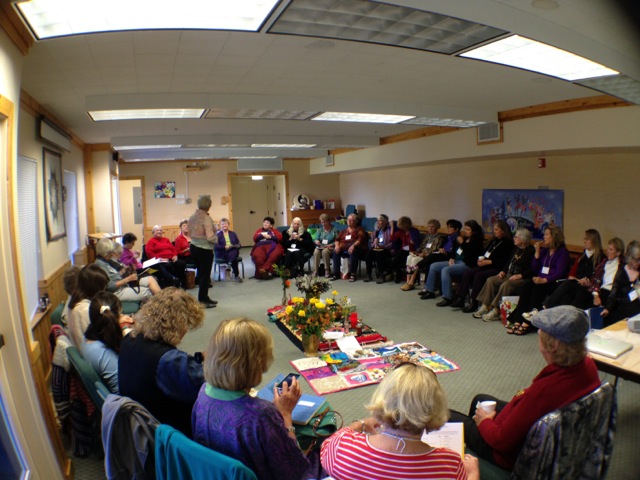 In the past week, I have done three interviews – two where I was guest speaker for online courses and one where I was a guest on an upcoming telesummit on feminine wisdom.
In the past week, I have done three interviews – two where I was guest speaker for online courses and one where I was a guest on an upcoming telesummit on feminine wisdom.
The theme that kept coming up in all three of those conversations, and in my recent talk at Patti Digh’s Design Your Life Camp, was this:
We don’t need another hero. (Thank you, Tina Turner.) What we need instead are people who will serve as hosts.
This is not an original thought to me, but the more I learn about it, the more central it has become to the work that I do. (I learned it first from my teachers Margaret Wheatley and Deborah Frieze, and have become immersed in it in my work with The Art of Hosting and Harvesting Conversations that Matter.)
We have built too many of our models (in business, government, church, Hollywood, etc.) on the expectation that someone will show up as the hero to save us from the ills of the world, or that we have to show up as the hero for someone else. What that does is create environments where our heroes have too much power, we assume that the rest of us don’t have the capacity to impact real change, and we become complacent in the face of violence, destruction of the earth, racism, economic imbalance, etc.
Here’s what Meg Wheatley has to say about the difference between a hero and a host:
You’re acting as a hero when you believe that if you just work harder, you’ll fix things; that if you just get smarter or learn a new technique, you’ll be able to solve problems for others. You’re acting as a hero if you take on more and more projects and causes and have less time for relationships. You’re playing the hero if you believe that you can save the situation, the person, the world.
Hosting Leaders create substantive change by relying on everyone’s creativity, commitment, and generosity. They learn from firsthand experience that these qualities are present in just about everyone and in every organization. They extend sincere invitations, ask good questions, and have the courage to support risk-taking and experimentation.
The more I learn about what it means to serve as a host leader, the more I am determined to incorporate it into every part of my life. I am a host leader in the way that I teach at the university, inviting my students into their own creativity, innovation, and way of learning instead of trying to impose my ideas on them. I am a host leader in the way I lead retreats, starting always in circle, where we look into each other’s eyes, see the humanity there, and share our stories in a way that invites both vulnerability and strength to show up. I am a host leader in the way that I parent, creating a container for my children to grow into the best version of themselves, instead of trying to mould them into my view of what they should be. I am a host leader in the way I coach, asking meaningful questions that will reveal my clients’ deepest wisdom and truth.
How can we be more intentional about serving as host leaders? Here are some of the thoughts that have emerged from my many conversations with my teachers and fellow-learners on the subject:
- Start with curiosity. Leaders are usually taught to be decisive and knowledgeable, and to “never let them see you sweat”. That’s a hero model that closes the door to new things showing up and to other people bringing ideas and questions into the room. Instead, open the door to possibility by being curious. What is opening up? What is possible? What do people bring? What would happen if…?
- Host yourself first. Get clear on who you are and where you stand. Find the practices that help to ground you in your own truth and wisdom and that help you withstand the pressures of ego and “the way things have always been”. Inquire into your own stories, triggers, and fears first so that you are more prepared to host what shows up in the circle. (A practice like Mandala Discovery can help with that.)
- Be vulnerable. Admit what you don’t know. Admit that you need other people. Admit your failings. It may seem counterintuitive, but vulnerability is one of the greatest strengths of a leader. Vulnerability invites courage, growth, and meaningful relationships.
- Invite vulnerability in others. Create a space where it is safe to fail, to fall apart, to not know the answer, and to take risks. People will show up with all of who they are when they know that they are safe.
- Trust other people and invite them to bring their creativity, commitment, and wisdom. Every time I teach, I begin by saying “I am not the only person who brought wisdom into the room. Everyone of you brought wisdom, and it is my hope that at some point in this class, you will feel comfortable enough to share it.” Trust them and give them autonomy.
- Ask good questions that open up meaningful conversations. Good questions are invitational rather than assuming. They invite energy rather than trying to contain it. They serve like a garden hoe, loosening the soil so that the seeds can grow.
- Be an active and engaged listener. An effective host leader spends a lot of time in silence. That’s something that’s taken me a lot of time to learn as a leader/teacher/parent – that I am more effective when I am listening to other people than when I am trying to fill the space with the knowledge I feel compelled to offer people. An effective listener/host allows the people in the circle to get closer to their OWN wisdom and stories rather than trying to adopt someone else’s wisdom.
- Start with a “heart at peace” rather than a “heart at war” (from the book Anatomy of Peace). A heart at war sees others as objects to be overcome, colonized, monopolized, directed, changed, while a heart at peace sees the humanity in each person.
- Rearrange the chairs. Most of our classrooms, boardrooms, conferences rooms, etc., are set up in a way that honours the hero model, with the expert at the front of the room. As my circle teachers, Christina Baldwin and Ann Linnea say, “change the chairs and you change the conversation.” Get people into circle and teach them that each person in that circle has some responsibility for holding the container and for honouring every other person in the room. There is no room for a hero leader in a circle.
If this is something you’d like to learn more about, I invite you to attend the upcoming Art of Hosting training that I’ll be co-hosting in Winnipeg in November. This is the kind of training that I wish everyone could take at some point in their life. The more of us who take it, the more the world will change.
by Heather Plett | Aug 21, 2013 | Community, Spirituality, Uncategorized
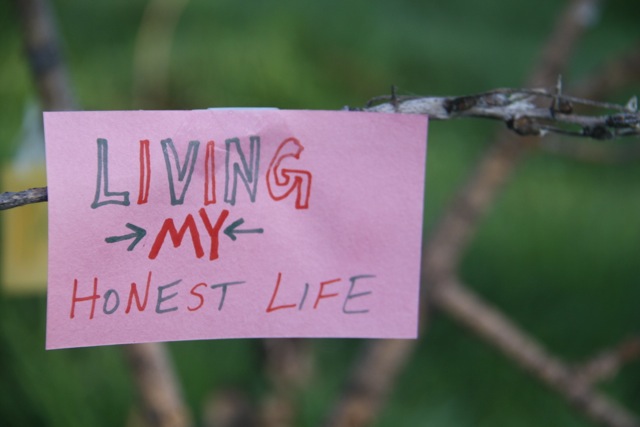
I am spiritual. That’s no surprise to you if you’ve been reading this blog for any period of time.
But it might be a surprise to you that I haven’t always been comfortable being “out” about my spirituality.
For starters, I was raised in a fairly conservative evangelical Mennonite family where faith was fairly black and white and you didn’t walk labyrinths, make prayer flags, take Buddhist meditation classes, pray to the Divine Feminine, embrace other faith perspectives, or talk about the way God speaks through a deer or a tree.
When I started exploring those things, I was afraid of rejection, and so I kept most of my exploration secret. There was a little too much fear of going to hell if you “worshipped false gods” in those circles, and that fear lingered deep in my own psyche long after I thought I’d dealt with it. I still don’t talk about it very much in some circles, and to be honest, I’m still excavating some of my rejection and fear stories around that. (I still consider myself a Christ-follower, by the way, but my understanding of what that means has shifted dramatically.)
For another thing, I spent a lot of years in the corporate world where any talk of spirituality was strictly taboo. Though I sometimes thought that my staff or the management teams I was on might be better off if we brought mindfulness and more spiritual openness into what we did, I wasn’t confident enough in my own exploration yet to introduce it. Again, it was mostly fear of rejection that kept me silent.
When I quit my job and started my own business, I started out as a split personality, still trying to keep my spirituality mostly in the closet. I had two websites – one was the polished, corporate-looking one I showed potential clients and students in my university classes, and the other was the blog where I explored the things that mattered most to me, including spirituality. Every time someone from the corporate/university world found the blog, I cringed a little, worried that they would no longer take me seriously as a consultant or teacher. There is, after all, an assumption in our culture that being spiritual means that you’re less intellectual and probably a little weaker than others.
About a year and a half ago, I started to realize that maintaining these two public faces was creating angst for me and making me feel disingenuous. After a couple of failed consulting gigs, I realized that I really didn’t want to work with clients who wouldn’t be comfortable with my spirituality. After trying to be something in the classroom I really wasn’t, I realized that my best teaching happened when I was authentically me.
And so I came out. I combined my blog with my website, integrated my spirituality into my consulting/facilitation/teaching work, and got used to stepping into a classroom where students and administration might think me a little “flakey or too woo-woo”.
I can’t tell you that it magically brought me all of the “right” kinds of clients (it’s still a gradual process), but I can tell you that things started to shift. In the very first class I taught after deciding to be more open and sharing my blog with students, I had four students approach me individually, interested in coming to me for coaching because they were looking for something deeper than they could receive in a classroom. And I started to get invitations to do amazing work that fits me perfectly, like the week long artists’ retreat I facilitated last week in Saskatchewan.
Yes, my work has shifted, and I’m sure a few corporate clients have been turned away by language that feels uncomfortable for them, but that’s okay.
More and more, my work is a true expression of who I am, not just the skills I can offer. More and more, I am bringing the full basket of my gifts and wisdom into what I offer.
And the right people are showing up. Almost all of my coaching clients, for example, share stories of how they too are trying to live more authentically and more boldly in a world that expects them to be more “corporate, straight, conventional, unemotional, etc.” They show up with their own fear of rejection stories and I can truly say “I see you.” And in the last six months, I’ve had the opportunity to host half a dozen retreat/workshops that are all about connecting on a deeper, more spiritual way. Again, I am more prepared to host them because I have been on my own journey to this deeper, more authentic place.
Another interesting thing has happened. Some of the people whose rejection I feared are coming forward and saying “Your work resonates with me. I’m curious about labyrinths/mandalas/etc. Can you tell me more?” My own “coming out” is encouraging others to be more honest about their own questions and exploration.
What about you? Do you sometimes feel like a fraud because you’re hiding the titles of the books you read from your colleagues at work? Do you take meditation classes in secret because you don’t want your family to know? Do you furtively read blog posts that make your heart sing, but you’re quite sure nobody in your world would understand? Do you feel like one of my clients, who said she is “kind of a weirdo, but in a good way”? Have you despaired of finding a circle of people like you who have questions that most people think are too “out there”?
You will need to find your own path through this, but you don’t have to do it alone. There are more of us spiritual seekers out here in this big world than you might imagine. Trust me – when I started being more open about my quest, I started connecting with a lot of amazing people who, like me, want to dive into meaningful conversations that go far beyond small talk, straight to the heart.
Here are a few thoughts on how you can begin to move into a more integrated, authentic life:
- Start small. Find at least one person who feels like a safe space to talk about your quest. This might be someone you already know and trust, someone at a yoga class, or a coach like me. Before you start the conversation, though, be sure that the person you’re talking to can respond in a non-judgemental way. If you face judgement in your very first conversation, your authentic you will run further into hiding.
- Find a place where you can be true to yourself. This might be your journal, a secret place in the woods, your favourite coffee shop or bookstore, or your art studio. In that space, commit to being totally honest with yourself about who you are and what you seek in the world. Read the books you want to read, write the truth that longs to be said, and dare to stand in awe of an eagle that seems to have a message just for you.
- Find a practice that connects you with your spiritual Self. There are many options – yoga, dance, meditation, walking, running, painting, mandala-making, etc. Do something that brings you peace and leaves you feeling connected to that authentic part of you that’s been buried under other people’s expectations.
- Practice truthfulness one tiny step at a time. If you are feeling inauthentic at work, find a least one co-worker whom you trust who won’t laugh at you when you admit to going on a meditation retreat. If that feels safe, take another step. You may be surprised to find other secret questers longing for the same conversation.
- Consider your priorities. If your steps to being more authentic at work feel unsafe or leave you feeling judged, consider how important it is to stay there. Is it time to walk away? Are you living a lie if you stay there?
- Recognize that some people will never “get it” and that’s okay. Some people might suggest that you should walk away from anyone who rejects your version of a spiritual quest, but life is far more complex than that. If a family member, for example, doesn’t understand it, then find other topics to talk about in their presence. You don’t need to lie to them, but you also don’t need to reveal your deepest heart to everyone in your life.
- Find community where you feel safe. With the internet making long distance relationships more and more accessible, it has become easier and easier to find circles where you can talk about your questions and spiritual quest. I wouldn’t say that virtual circles replace in-person relationships, but it’s at least a place to start. For example, many of the people who sign up for Lead with Your Wild Heart say that one of the best things about the program is the fact that they no longer feel alone in their quest for authenticity.
- Read a book or two that helps you understand your own quest. A few recommendations: Falling Upward: A Spirituality for the Two Halves of Life, A Hidden Wholeness: The Journey Toward an Undivided Life, The Seeker’s Guide: Making your Life a Spiritual Adventure, and What We Talk About When We Talk About God.
In all that you do, remember this – this journey is a long one. You don’t get to authentic overnight. It took me many years to realize some of the places I was living a divided life, and I know that there are still more realizations to come.
Take the journey one step at a time, and find companions along the way.
by Heather Plett | Aug 15, 2013 | art, Beauty, circle, Community, grace, Spirituality
I am home after nearly two weeks of journeying across the prairies. It was amazing. I am replenished, encouraged, and feeling full of the goodness of this earth and the people on it.
I am still on a bit of a high and not entirely sure that I have the right words to articulate what this journey meant for me, but I’m going to try anyway, before it slips too far into the past and is lost in a sea of other stories that want to be told.
Part 1: Journey to myself
“In solitude, at last, we’re able to let God define us the way we are always supposed to be defined—by relationship: the I-thou relationship, in relation to a Presence that demands nothing of us but presence itself. Not performance but presence.” – Richard Rohr
Though I could have easily gotten to Calgary with one long day of driving (and have done it many times), I chose to make the trip in two days so that I could savour the trip and enjoy a night of camping by myself. As Richard Rohr writes in Falling Upward, the older I get and the more I learn to love and understand myself, the more I enjoy my own company.
From the moment I left the city limits, I knew there was going to be something special about this journey. It was a stunningly beautiful day, with the kind of fluffy, storybook clouds artists and photographers pine for. It was also the perfect season, when there are still rich summer greens mixed with subtle autumn golds, browns and reds. The canola and flax are in full bloom, the wheat and barley fields are readying themselves for harvest, the round bales are beginning to be laid out across golden hay fields, and the calves born in early summer are strong, virile, and rambunctious.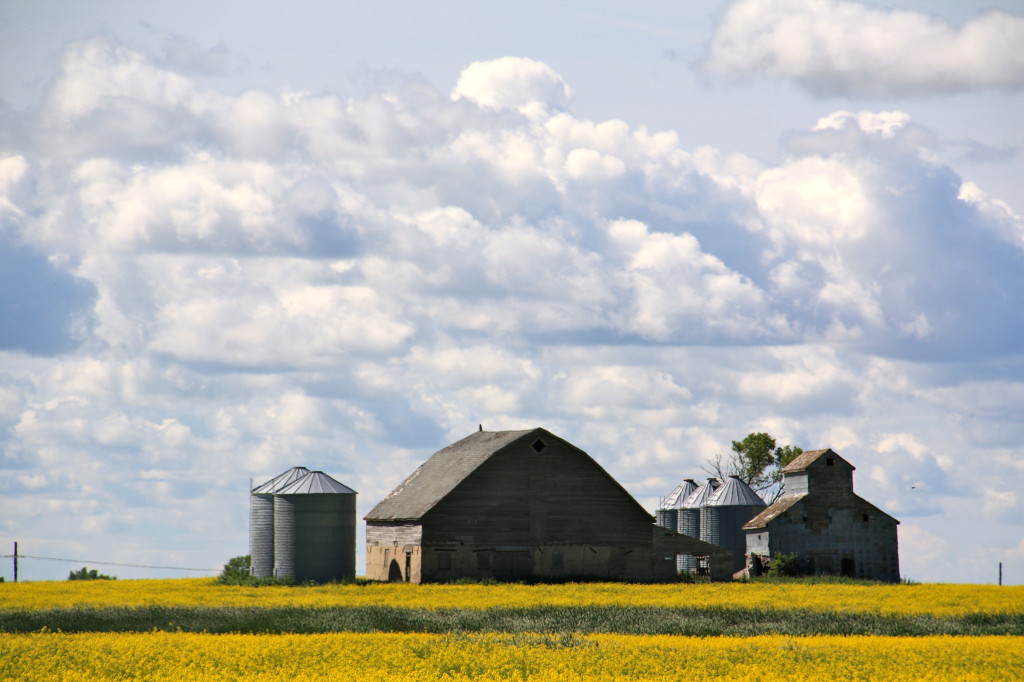
Everywhere I looked, the prairies seemed to be laying out their finery for me. I couldn’t resist stopping for photos of bright red barns set against bold blue skies, fields where flax flowers flowed like the waves on a peaceful sea, and ditches where butterflies and dragonflies danced from wildflower to wildflower.
When I pulled into Regina, I stopped for a bottle of wine and a cheap plastic wine glass (to enhance the picnic I’d brought from home) and headed to my campsite by a lake. The first thing I spotted at the campsite was a shiny loonie (dollar) on the ground – like someone had left it as a good luck charm.
Pushing through a broad strip of clover that stood higher than my head and smelled of heaven, I came to the lake. There in front of me, for no reason I could ascertain, was a picnic table half submerged in water. I waded out to the table and sat on it for awhile, snapping photos of fishermen, seagulls and rocks. The sun was about two hours from sunset, as far as I could tell, but I didn’t want to miss a moment of its setting. So I brought my picnic lunch and journal to the table and spent the next two hours on my little wooden island in the lake, hidden from view from most people by the huge stand of clover along the shore.
Those two hours were magical. My senses were heightened after a day full of prairie beauty, and every angle, every bit of light, every shadow, every rock, every bird, every line, and every reflection was drenched in beauty. For two hours I sat in awe, watching the light change on the lake and the clouds glow in the sky. God’s presence was palpable. It was one of those thin places that the Celts talk about, where heaven and earth collide.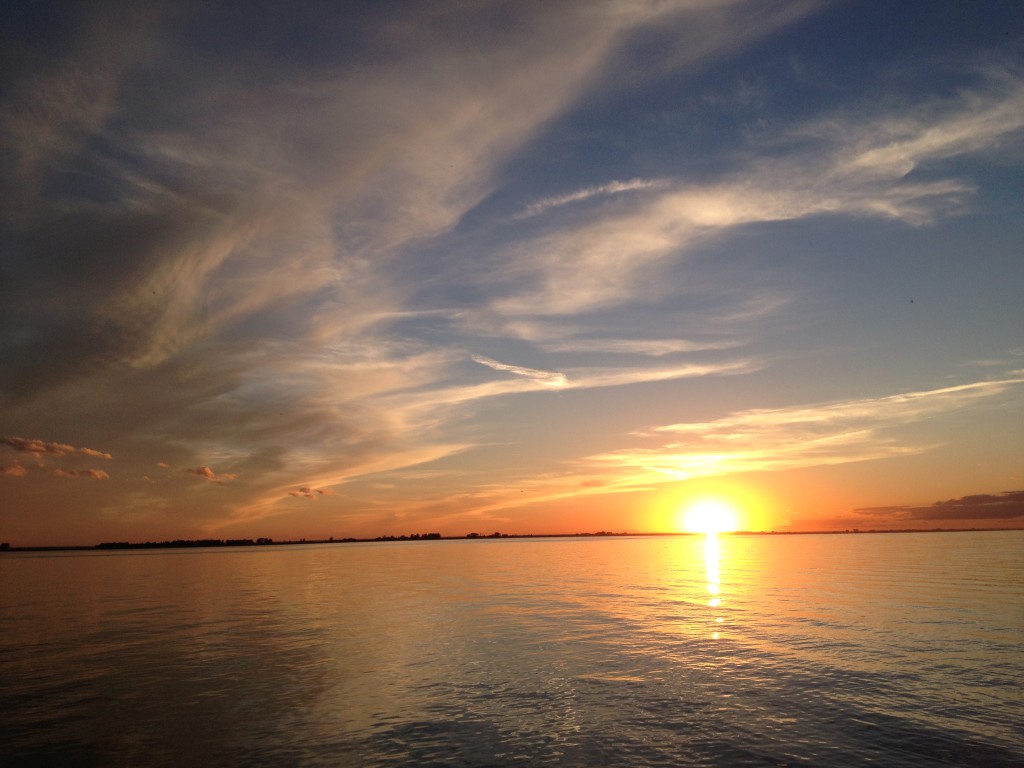
After the sun set, and night began to drift across the lake, I lit a fire at my campsite and had another magical hour of capturing light of a different kind – orange, glowing, flickering, pushing against the darkness. From the largeness of the sunset sky to the smallness of my cast iron fire pit – I was mesmerized by light.
The next day was much like the one before, with equally piercing blue skies and impossibly white clouds. I wandered on the beach, took pictures of more birds, feathers, and rocks, and then started the drive to Calgary. At one point, a storm rolled in, and the clouds changed to dark and dramatic. After two days of beauty, I wasn’t surprised to see a rainbow show up.
By the end of the day, I felt like I had just been courted by a devoted lover who was doing everything s/he could to make me feel special. In the words of Richard Rohr in the quote above, I was very much in “the I-thou relationship, in relation to a Presence that demands nothing of us but presence itself.” I found God on the prairies and God laid out the finest that the prairies had to offer to make sure I felt loved.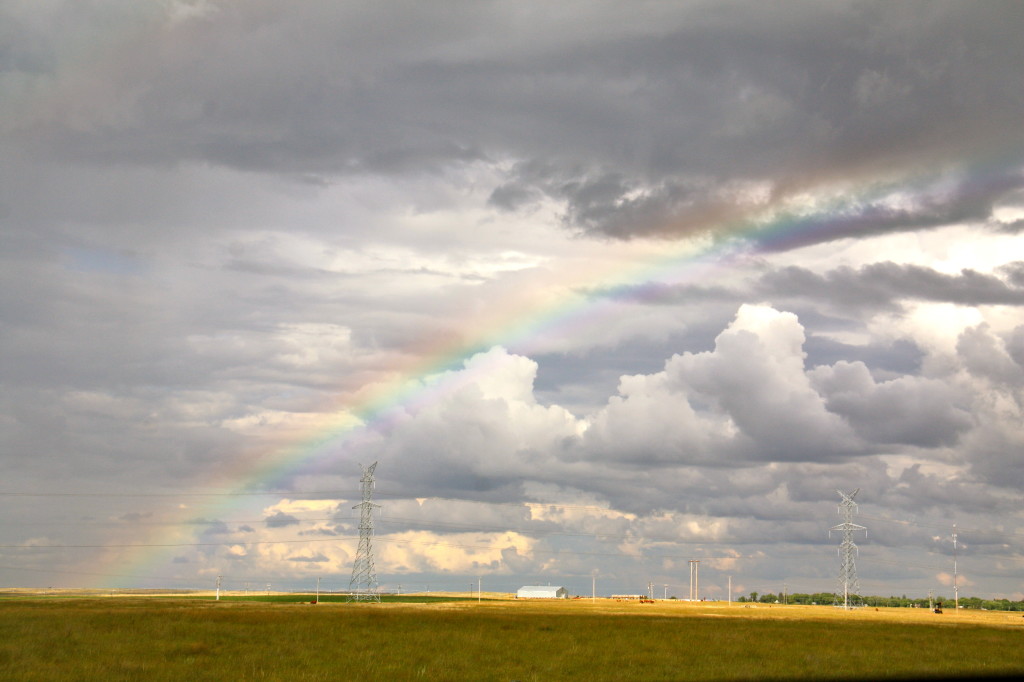
For more photos of my prairie journey, here’s a little video I put together.
Part 2: Journey to my family
“Always remember, there was nothing worth sharing
Like the love that let us share our name.” – The Avett Brothers
The purpose for my trip to Calgary was to visit my oldest brother, Brad, who’d been diagnosed with cancer a few weeks earlier and had had a three foot section of his colon removed the week before. When I’d heard about his cancer, I’d felt an intense need to spend time with him, and so I took advantage of the opportunity. It’s been a hard year for our family, after losing Mom to cancer in November, so the bond between us feels especially important.
If you met my big brother, you might marvel at the many ways that our world views are different, and – on the surface level – you might even question how we find common ground. His politics lean further right than mine do, he’d rather spend the afternoon in a hockey rink while I’d choose an art studio, and he doesn’t see the point in much of the self-discovery or community-building reading and writing I do while I’d be bored to tears with the kind of detail-oriented computer coding he does. (It almost seems like a cliche that he has a degree in math and I have a degree in literature.)
And yet… if you looked at only those things, you’d be missing a lot. For one thing, there’s something about 47 years of shared history, stories, jokes, faith, questions, and grief that creates a common language that few people in the world can understand. There is great safety and comfort in that common language, especially after you’ve lost a few of the only people on earth who know it. When you are in a place where you can speak that language and ask those questions without fear of judgement, it is worth more than gold.
And there’s another thing… unleash us in the mountains, on the prairies, or by the seashore with our cameras, and both of us can wander happily for hours. (Or – in the case this week – lament the fact that we can’t wander for hours due to a recently broken foot and major surgery.) And then we can sit together on the couch for another couple of hours going through the pictures to find the few in which we’ve captured the light just right.
In those things, there is plenty of common ground to make a trip across two provinces after a cancer scare an indescribably worthwhile thing to do.
I didn’t know how this visit would go, and frankly, I was a little worried to see what cancer was doing to my normally energetic and adventurous brother. On top of that, my sister-in-law (whom I also love dearly, and would easily cross two provinces for as well), has been dealing with some pretty heavy things this year, and my teenage niece has had an interesting recent time of learning more about her identity as well.
I expected their home to be full of turmoil and sadness… and yet… it wasn’t. There was a surprising amount of peace and grace in their home, not to mention a whole lot of love. My brother has a remarkable capacity for accepting life as it is and enjoying every moment that he can, and my sister-in-love has a remarkable capacity for making meaning of what is and articulating it in a way that shines new light into it. Plus they both have a deep faith that sustains them and gives them hope.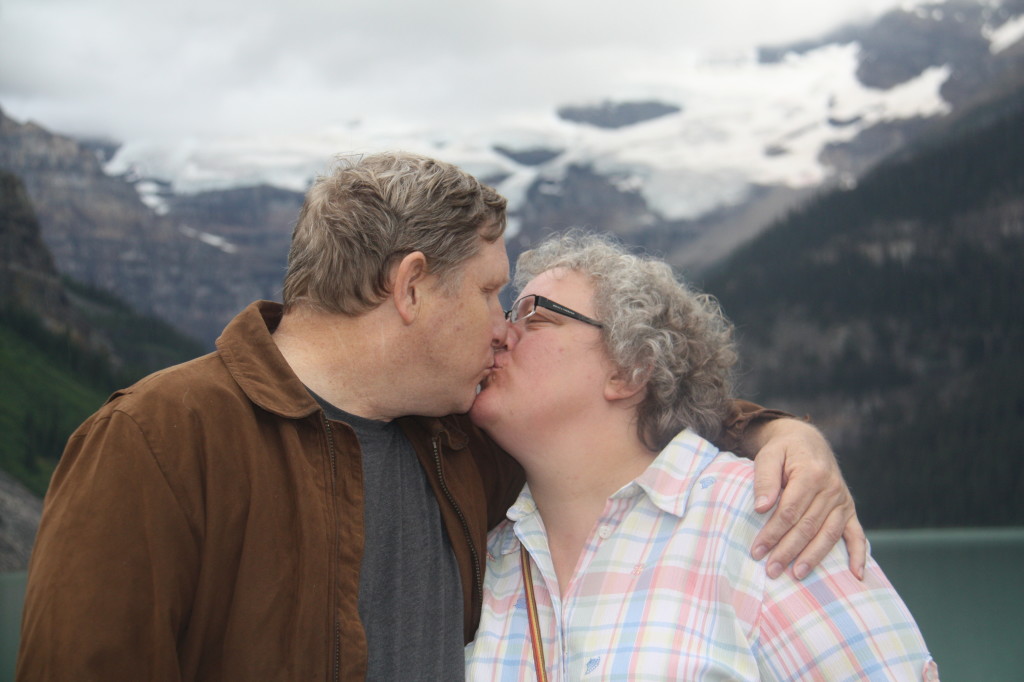
One of the most poignant moments of the visit was when I stood next to my brother in church (yes, he’s stubborn enough to go to church two days after being released from the hospital) and sang “Come Thou Fount”, a song that has a rich history in our family and was sung at both of our parents’ funerals. “Here I raise mine Ebenezer; hither by thy help I’m come; and I hope, by thy good pleasure, safely to arrive at home.” The Bible verse that those lines are inspired by was made into a wall hanging for Mom and Dad’s 25th anniversary, and hung in their home for twenty-three years after that until Dad died and the farm was sold.
Another poignant moment was standing at the shores of Lake Louise on a drive into the mountains. My recently broken foot and his surgery wounds meant that we couldn’t walk far, but it felt like a moment of grace to be able to stand there with him and Sue, enjoying the beauty around us. We are all broken people, heading inevitably to our deaths, and yet there are moments of beauty, grace, and light, and for that we carry on in this journey.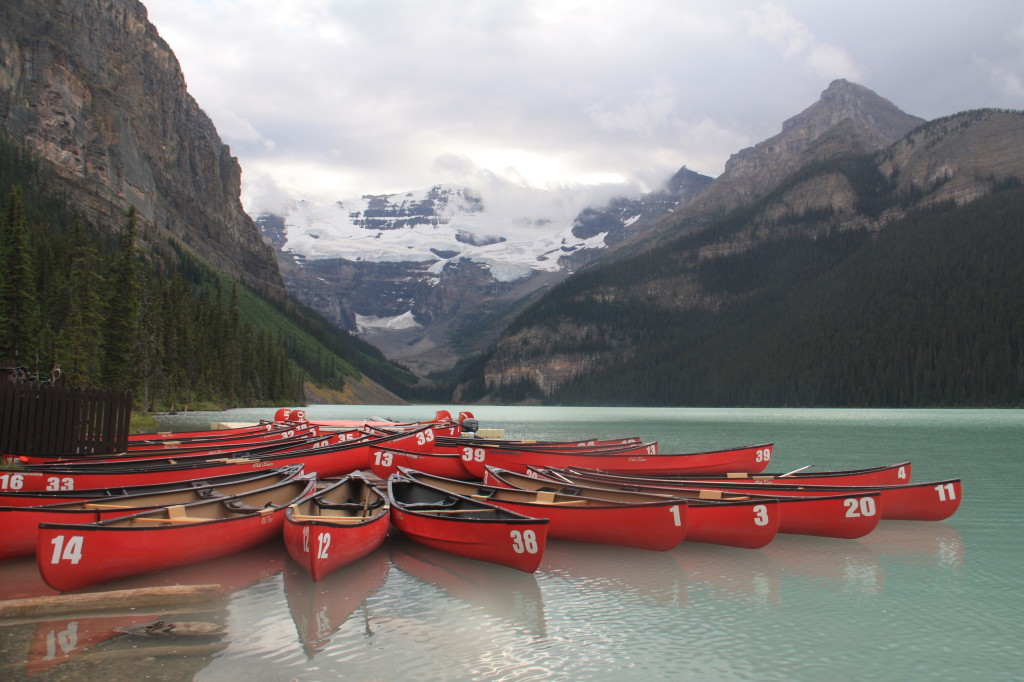
Part 3: The journey to others
“In helping others, we shall help ourselves, for whatever good we give out completes the circle and comes back to us.” ~ Flora Edwards
The final destination on this journey was a small prairie town, perched on the border between Saskatchewan and North Dakota, that looked a lot like the prairie town I grew up in. In North Portal, people trust each other enough to not only leave their doors unlocked but to leave the border unlocked. When you go golfing, you start out in one country and end in another, and they trust you to leave the parking lot through the same entrance (Canadian or American) that you entered through – no passport required. There used to be churches on either side of the border, but when their numbers dwindled, they joined and now meet in the new Canadian church in winter and in the older American church in summer.
In that town, there is an old school building that looks a lot like the place I spent the first nine years of my school life. There are not enough kids in town to fill it anymore, so they started bussing the kids to another town and sold the building to one of the townsfolk who put a friendly neighbourhood bar in one classroom and rents the other classrooms out to artists, healers, and others who need space.
In that building, Visions Art Guild holds their annual retreat. It’s a blissful week of summer camp for artists, with the local church ladies catering their meals, and everyone pitching in to do the dishes and keep the place clean. During the day, they make lots of art, have occasional inspirational sessions, and encourage each others’ creativity. In the evenings, they drink wine, make a little more art if they feel like it, and have a few good belly laughs (especially on the night of Frida Fest, when everyone dresses as their favourite Frida Kahlo painting or photo).
Every second year, they bring in a facilitator to inspire them in some area of growth. This year I was that lucky facilitator. On the theme of journey, I was invited to do three full sessions (a couple of hours each), three mini-sessions (about 45 minutes each), and one-on-one coaching sessions for anyone who wanted them (nine sessions). In between I got to make my own art and wander from station to station being inspired by the different styles and different mediums. Some worked in acrylics, watercolour, and oil, one added tiny twirly stitches to art prints, one did beautiful beadwork, one made fanciful beings out of found objects, one played with adding fabric prints of her prairie photos to her loomed rugs, one incorporated hand-dyed paper with natural objects, and one worked on a complex mixed media collage backdrop for her fanciful raven drawings. I dabbled with acrylics, watercolours, and mandalas, and took a lot of photos.
At the beginning of our week together, one of the retreatants helped me make a labyrinth in the grass, and that became the foundation of our exploration into the theme of journey. On the second day, I read Dr. Seuss’ “Oh the Places You’ll Go”, made road signs for the twelve places in the journey from the book (the prickly perch, the waiting place, etc.), and added those to the labyrinth. In addition, I’d collaged the words they’d sent me in response to some advance journal prompts onto a long piece of paper that represented the journey we were on for the week, and that piece of paper became a group art project that we added to throughout the week. We also made prayer flags to represent the things we most want to invite into our lives, our art, and our relationships.
What can I say about that week? For starters, it was SO MUCH FUN! Hanging out with artists and being inspired by their creative techniques and their capacity to see beauty made my own artist heart soar. For another thing, it was SO RELAXING! Yes, I was facilitating and coaching, but there was just so little pressure and the women in the group were delightful to work with and host in circle. They were receptive and responsive to my questions, they jumped into my activities with their whole hearts, and they embraced me as one of their own. And for another thing, it was very, very FULFILLING. In the coaching conversations, when I saw their faces soften with some new wisdom that was growing in them, and in the circle when I saw them opening themselves to new stories that will help them walk in the world with new courage, I knew that God was working through me to create safe space for their authenticity to show up.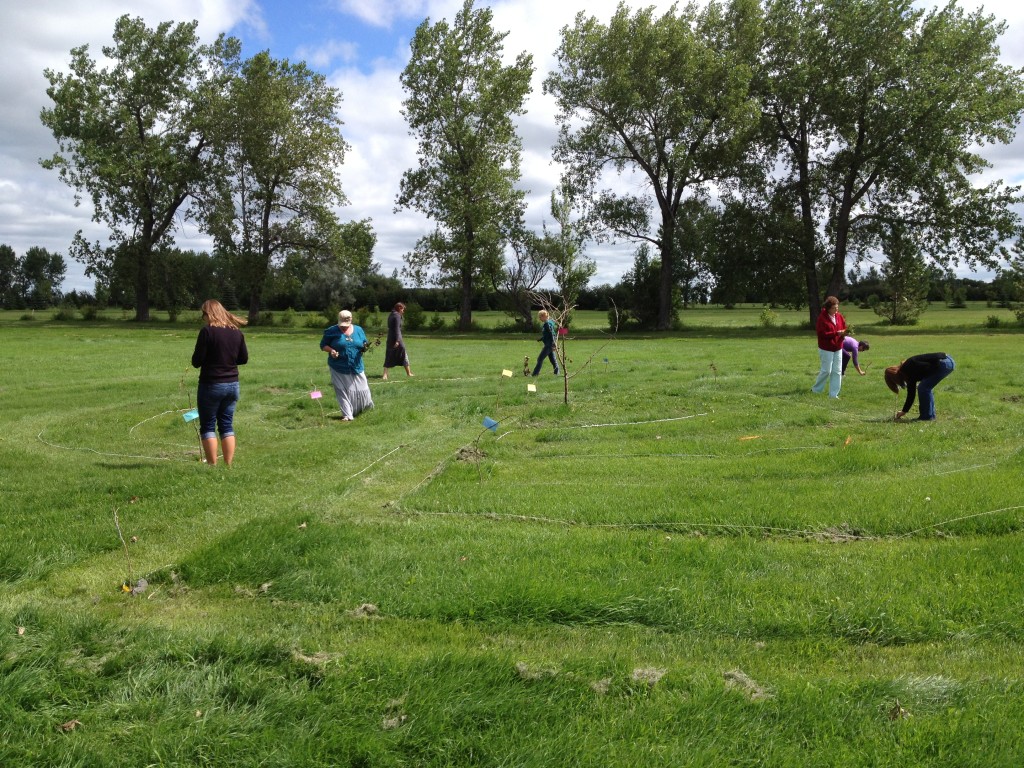
This is my absolute favourite kind of work – gathering women in circle and fostering their growth, creativity, and leadership. This is the kind of work that feels so much like play I almost feel guilty when they pay me at the end of the week.
I left that little prairie border town feeling like I was floating on a cloud. That beautiful circle of women gifted me with more than I could have possibly gifted them. They gave me tangible gifts (shoes, jewelry, a hand-woven rug, artist trading cards, and more), but the intangible gifts were far greater. They gave me love, acceptance, inspiration, and trust.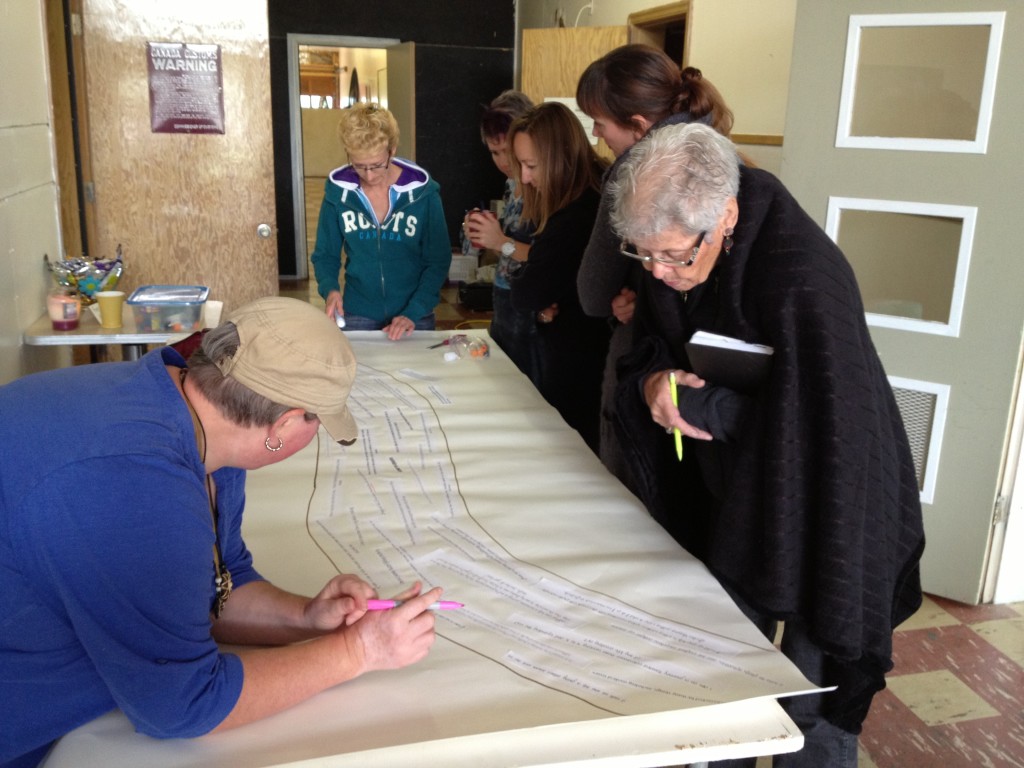
Part 4: The scary part of the journey that reminds me of the value of all the rest
“If you live to be a hundred, I want to live to be a hundred minus one day so I would never have to live without you.” ~Winnie the Pooh
This part of the journey was so brief it hardly bears mentioning, and yet it was so impactful it belongs on this page.
About an hour before I got home, driving along a single lane highway, a half-ton truck coming toward me swerved into my lane when it was only about 100 metres away and came at me full speed. I swerved onto the gravel shoulder on my right, and then the truck swerved there too, looking like the driver was determined to kill me. I swerved left (thankfully there was no other traffic), missed the speeding truck by mere inches, and then started spinning out of control, convinced I would end up rolling in the ditch. I finally came to a stop in the middle of the road, and turned back into my lane.
In the rearview mirror, I could see that the truck had turned around and was coming toward me again. I took off as quickly as I could, not interested in sticking around to see if they were coming to check if I was okay and apologize or try to kill me again.
The rest of the way home, my heart was racing, and I kept bursting into spontaneous tears. Just the day before, while still at the retreat, I’d gotten an email from Brad saying that the prognosis on his cancer is not good, that it has spread to his liver and possibly his lungs, and that – even with chemo and surgery – there is an 80% chance the cancer will kill him within 5 years. Between my near-death moment and the knowledge that I might soon lose my brother, life started feeling exceedingly fragile.
When I got home, hugs from my kids and a hot bath helped calm me down. I had to host a call for Lead with Your Wild Heart, so I did what I could to centre myself and be present for whoever showed up. Fortunately, the call morphed into a delightful hour-long conversation about the value of hosting meaningful conversations in circle, and I became energized talking about the work that most inspires me. That call also inspired me to write the following on Facebook:
Life is short. I know it sounds cliched, but believe me – it is. One day you find out there is an 80% chance your brother’s cancer may kill him in less than 5 years, and the next day a crazy driver tries to kill you, and then you find out a dear friend is having eye and kidney complications far away in South Africa and you can’t hug her, and everything just feels so fragile that you want to gather everyone around you and hug them and tell them to BE REAL, BE PRESENT, and BE GOOD TO EACH OTHER. There is just NO DAMN POINT in wasting your time doing things that are not authentic and full of love and true to the purpose God put you on this earth for.
Please… do me a favour, and stop wasting your time with lies and masks and artificial lives. Stop trying to please the people who don’t have your best interests at heart. Stop trying to live up to an unrealistic ideal that has nothing to do with who you are. Stop trying to find your happiness in money and possessions and fake happiness. Find people who believe in the beauty that is in you, hang onto them, and don’t stop holding each other until you all emerge with more courage to do the things the world is longing for you to do. And then hold onto each other some more, until you have spread every last bit of love God has put in you to spread and your work on this earth is done.
I nearly died on the highway today, and that moment shook me to the core, but at least I can say one thing… I would have spent my last week on earth doing EXACTLY the kind of work that I was put on this earth for – hosting REAL people in circle, giving them a safe space to be authentic, encouraging their creativity, and inviting them to live to their most beautiful potential.
I will keep doing this work and spreading this love until my time is done. Are you with me?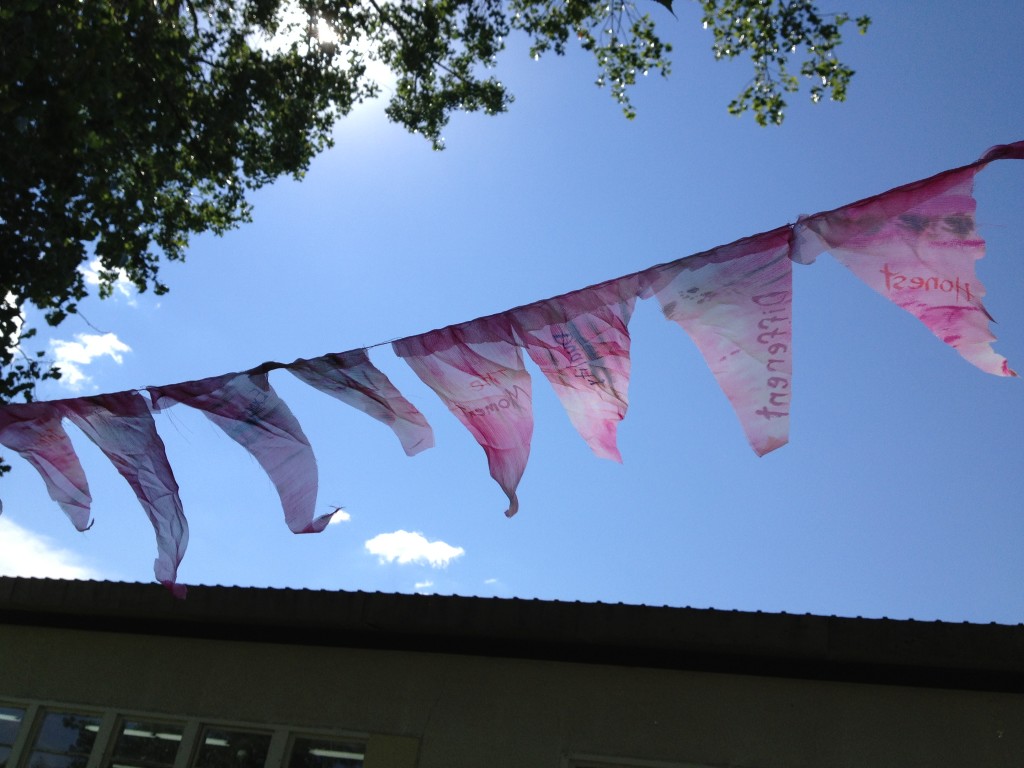
And with that, I end this part of my journey but continue on with the ongoing journey of my life, loving the people around me, living in the beauty that God is making of me, and serving the world with the gifts that have been entrusted to me with whatever time is left for me on this earth.
If you’re on a similar journey to a deeper place, and could use a guide to help you, consider signing up for one of my “Back to School” coaching sessions.
by Heather Plett | Jun 28, 2013 | Uncategorized
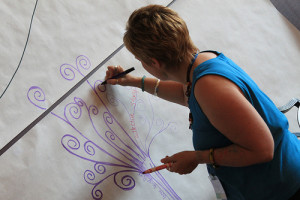
I’m not very good at being an expert.
As I’ve been building this business around writing, coaching, and teaching, I continue to have some discomfort around people’s expectation that I become The Expert. I get emails from people who want advice on how to be a better leader/teacher/artist. My students ask me for advice on how to be a better writer/communicator/speaker. Underneath their questions, I hear the unspoken words “you’re The Expert and I’m the amateur – please give me the formula for how to be successful in this.”
Each time I hear the unspoken words, I chafe a little. I don’t want to be The Expert. I don’t want to tell them how to do it. I don’t mind sharing what I’ve learned, or telling them a story from my own experience (that’s why I teach, after all), but mostly I want to help them find their own wisdom. And I want to tell them that “you’ll only get better if you keep practicing.” And “why don’t you find a community of people who are doing this work who can support you in your quest for understanding?”
People get tired of hearing those answers from me. They simply want The Answer. They want to be handed the key that will open the door into The Land of Success. And then, when The Land of Success doesn’t look quite like they expected, they want to be able to say “it’s not MY fault. I was simply following the advice of The Expert.” That’s the way our culture has trained us to think – experts have the answer, banks control the money, teachers have the wisdom, lawyers and judges and police officers control justice, doctors know about health, etc.
It used to be the same when I was in a leadership position that attached the word “Director” to my name. Surely someone who’s a Director should be comfortable with being The Expert and The Boss, right? Wrong. Even back then, I would answer my employees questions with “What do YOU think is the right course of action?” and “Where do YOU think we should look for better solutions to these challenges?” and “What do YOU think our vision should be?” Occasionally my employees got rather upset with me. One of them, who loved to refer to me as The Boss (especially when he knew it made me uncomfortable) would remind me on an annual basis “You’re getting paid the big bucks – it’s YOUR job to tell us what the vision is and it’s our job to carry out that vision.”
Umpteen leadership books, coaches, and motivational speakers told me exactly what he’d said. “Leaders are supposed to hold the vision.” “You shouldn’t be afraid to call yourself The Expert. You’ve earned this – claim it.” And so I began to doubt my own self-confidence. Maybe I SHOULD be The Director who spells out The Vision for my team. Maybe I SHOULD be The Expert who tells her students exactly how things should be done. Maybe I shouldn’t shy away from being seen as The One Who Holds The Answers/Vision/Knowledge/Truth.
And so I tried on that hat a few times. I tried to act more confident, show off my knowledge more, and let people refer to me as The Expert. Own it, claim it, wear the hat – that’s what the motivational speakers said. But the hat didn’t fit. And it made my head itchy.
So I went back to asking questions, sharing stories, and helping people find their own wisdom. THAT hat fit me perfectly.
That’s why, when I discovered The Circle Way a dozen years ago, and then The Art of Hosting three years ago, I knew I had found my home.
In a circle, there are no experts – instead there are stories, questions, tears, longings, dreams – and a bunch of equal people who trust their own wisdom and each others’.
As a host, there is no need to be an Expert or The Keeper Of The Truth – instead there is the need to create a container where people can experience safety and trust, and where ideas and questions are more valuable than Visions. There is the need to help people find their own wisdom. And there is the need to be attuned to the energy in the room and the place where the group wants to go.
The more I learned, the more I became convinced that this is the kind of leaders and teachers we need in the world. The way I’d always felt compelled to lead was not because of my lack of confidence, it was because of my intuitive sense that something different was needed. Finally learning to trust that intuitive sense was one of the best things I’ve ever done.
That’s why I am delighted that, after several years of dreaming of it, I’m helping to bring The Art of Hosting and Harvesting Conversations That Matter to my home province. We’re doing a one-day “taster” workshop in July, and then we’ll host a three-day version in October.
Join us! There will be a comfortable place in the circle for you!












